Natural Language Processing Influence on Digital Socialization and Linguistic Interactions in the Integration of the Metaverse in Regular Social Life
Abstract
1. Introduction
2. Related Work
3. Exploring the Impact of NLP Collaboration with the Metaverse on Real-Life Applications
3.1. AI–Player Interaction Virtual Game
3.2. Interactive Training Companion
3.3. Language Learning Composition
3.4. Interactive Museum and Exhibition
3.5. Personalized Fitness Coach
3.6. Virtual Mental Health Assistant
3.7. Virtual Tour Guide
3.8. Customized News and Media
3.9. Virtual Conference
4. Revolutionizing Daily Life: The Multifaceted Impact of NLP and Metaverse Collaboration
4.1. Revolutionizing Learning
4.2. Enhancing Assistance in the Digital Age
4.3. Revolutionizing Amusement
4.4. Customizing Digital Personal Experiences
5. Breaking Language Barriers: Leveraging NLP and Metaverse for Multilingual Conferences with Speech-to-Text and Text-to-Speech Translation
6. Discussion
7. Conclusions
Author Contributions
Funding
Conflicts of Interest
References
- Mystakidis, S. Metaverse. Encyclopedia 2022, 2, 486–497. [Google Scholar] [CrossRef]
- Owens, D.; Mitchell, A.; Khazanchi, D.; Zigurs, I. An empirical investigation of virtual world projects and Metaverse technology capabilities. In ACM SIGMIS Database: The DATABASE for Advances in Information Systems; Association for Computing Machinery: New York, NY, USA, 2011; Volume 42, pp. 74–101. [Google Scholar] [CrossRef]
- Shannon, L. Interconnected Realities: How the Metaverse Will Transform Our Relationship to Technology Forever; John Wiley & Sons: Hoboken, NJ, USA, 2023. [Google Scholar]
- Tunca, S.; Sezen, B.; Wilk, V. An exploratory content and sentiment analysis of the guardian Metaverse articles using leximancer and natural language processing. J. Big Data 2023, 28, 82. [Google Scholar] [CrossRef] [PubMed]
- Solska, D. Traversing the Metaverse: The new frontiers for computer-mediated communication and natural language processing. Forum Filol. Ateneum 2022, 10, 27–38. [Google Scholar] [CrossRef]
- Swaminathan, A.; López, I.; Mar, R.A.G.; Heist, T.; McClintock, T.; Caoili, K.; Grace, M.; Rubashkin, M.; Boggs, M.N.; Chen, J.H.; et al. Natural language processing system for rapid detection and intervention of mental health crisis chat messages. NPJ Digit. Med. 2023, 6, 213. [Google Scholar] [CrossRef] [PubMed]
- Millstein, F. Natural Language Processing with Python: Natural Language Processing Using NLTK; CreateSpace: Scotts Valley, CA, USA, 2020. [Google Scholar]
- Abdari, A.; Falcon, A.; Serra, G. Metaverse Retrieval: Finding the Best Metaverse Environment via Language. In Proceedings of the 1st International Workshop on Deep Multimodal Learning for Information Retrieval, Ottawa, Canada, 29 October–3 November 2023; pp. 1–9. [Google Scholar] [CrossRef]
- Park, S.-M.; Kim, Y.-G. A Metaverse: Taxonomy, components, applications, and open challenges. IEEE Access 2022, 10, 4209–4251. [Google Scholar] [CrossRef]
- Chew, H.S.J. The use of artificial intelligence–based conversational agents (Chatbots) for weight loss: Scoping review and practical recommendations. JMIR Med. Inform. 2022, 10, e32578. [Google Scholar] [CrossRef] [PubMed]
- Çengel, M.; Yildiz, E.P. Teachers’ Attitude Scale Towards Metaverse Use: A Scale Development Study. Educ. Q. Rev. 2022, 5. [Google Scholar] [CrossRef]
- Gross, A.; Murthy, D. Modeling virtual organizations with Latent Dirichlet Allocation: A case for natural language processing. Neural Netw. 2014, 58, 38–49. [Google Scholar] [CrossRef]
- Atefeh, F.; Inkpen, D.; Hirst, G. Natural Language Processing for Social Media; Morgan & Claypool: San Rafael, CA, USA, 2015. [Google Scholar]
- Thanveer, S.; Tao, X.; Li, Y.; Dann, C.; McDonald, J.; Redmond, P.; Galligan, L. A review of the trends and challenges in adopting natural language processing methods for education feedback analysis. IEEE Access 2022, 10, 56720–56739. [Google Scholar] [CrossRef]
- Robert, G.-J. Emerging Spaces for Language Learning: AI Bots, Ambient Intelligence, and the Metaverse; National Foreign Language Resource Center: Honolulu, HI, USA, 2023. [Google Scholar]
- Shweta, S.; Dubey, R.K. Automatic speech recognition for connected words using DTW/HMM for English/Hindi languages. In Proceedings of the 2015 Communication, Control and Intelligent Systems (CCIS), Mathura, India, 7–8 November 2015; IEEE: Piscataway, NJ, USA, 2015; pp. 199–203. [Google Scholar] [CrossRef]
- Yoshifumi, O.; Miyazaki, M.; Ikehara, S. Natural language processing in a Japanese text-to-speech system. In Proceedings of the 15th Annual Conference on Computer Science; Association for Computing Machinery: New York, NY, USA, 1987; pp. 40–47. [Google Scholar] [CrossRef]
- Eric, B. Processing natural language without natural language processing. In Proceedings of the International Conference on Intelligent Text Processing and Computational Linguistics, Mexico City, Mexico, 16–22 February 2003; Springer: Berlin/Heidelberg, Germany, 2003; pp. 360–369. [Google Scholar]
- Samuel, C.-L.; Denis, A.; Bellalem, N. Linguistic and multilingual issues in virtual worlds and serious games: A general review. J. Virtual Worlds Res. 2014, 7, hal-00949908. [Google Scholar] [CrossRef][Green Version]
- Nakahira, K.T.; Rodrigo, N.R.; Taguchi, R.; Kanematsuy, H.; Fukumural, Y. Design of a multilinguistic Problem Based Learning learning environment in the Metaverse. In Proceedings of the 2010 2nd International Symposium on Aware Computing, Tainan, Taiwan, 1–4 November 2010; IEEE: Piscataway, NJ, USA, 2010; pp. 298–303. [Google Scholar] [CrossRef]
- Van der Land, S.; Schouten, A.P.; Hooff, B.V.D.; Feldberg, F. Modeling the Metaverse: A theoretical model of effective team collaboration in 3D virtual environments. J. Virtual Worlds Res. 2011, 4. [Google Scholar] [CrossRef]
- Seebun, G.R.; Nagowah, L. Let’s talk: An assistive mobile technology for hearing and speech impaired persons. In Proceedings of the 2020 3rd International Conference on Emerging Trends in Electrical, Electronic and Communications Engineering (ELECOM), Balaclava, Mauritius, 25–27 November 2020; IEEE: Piscataway, NJ, USA, 2020; pp. 210–215. [Google Scholar] [CrossRef]
- Ball, M. The Metaverse: And How It Will Revolutionize Everything; Liveright Publishing: New York, NY, USA, 2022. [Google Scholar]
- Lee, J.; Kim, Y.; Choi, J.; Kim, K.-H.; Kim, D. Human Detection using Real-virtual Augmented Dataset. J. Inf. Commun. Converg. Eng. 2023, 21, 98–102. [Google Scholar] [CrossRef]
- Bender, E.M. Linguistic Fundamentals for Natural Language Processing: 100 Essentials from Morphology and Syntax; Springer Nature: Berlin/Heidelberg, Germany, 2022. [Google Scholar]
- Panagiotakopoulos, D.; Marentakis, G.; Metzitakos, R.; Deliyannis, I.; Dedes, F. Digital scent technology: Toward the internet of senses and the Metaverse. IT Prof. 2022, 24, 52–59. [Google Scholar] [CrossRef]
- Prabadevi, B.; Deepa, N.; Victor, N.; Gadekallu, T.R.; Maddikunta, P.K.R.; Yenduri, G.; Wang, W.; Pham, Q.V.; Huynh-The, T.; Liyanage, M. Metaverse for Industry 5.0 in NextG Communications: Potential Applications and Future Challenges. arXiv 2023, arXiv:2308.02677. [Google Scholar]
- Fernando, A.-F.; Fierrez-Aguilar, J.; Ortega-Garcia, J. A review of schemes for fingerprint image quality computation. arXiv 2022, arXiv:2207.05449. [Google Scholar]
- Lin, Y.; Chen, L.; Ali, A.; Nugent, C.; Ian, C.; Li, R.; Gao, D.; Wang, H.; Wang, Y.; Ning, H. Human Digital Twin: A Survey. arXiv 2022, arXiv:2212.05937. [Google Scholar]
- Wang, Y.; Su, Z.; Zhang, N.; Xing, R.; Liu, D.; Luan, T.H.; Shen, X. A survey on Metaverse: Fundamentals, security, and privacy. IEEE Commun. Surv. Tutor. 2022, 25, 319–352. [Google Scholar] [CrossRef]
- Wu, D.; Yang, Z.; Zhang, P.; Wang, R.; Yang, B.; Ma, X. Virtual-Reality Inter-Promotion Technology for Metaverse: A Survey. IEEE Internet Things J. 2023, 10, 15788–15809. [Google Scholar] [CrossRef]
- Fernandes, F.; Werner, C.M.L. A Systematic Literature Review of the Metaverse for Software Engineering Education: Overview, Challenges and Opportunities; PRESENCE: Washington, WA, USA, 2022. [Google Scholar] [CrossRef]
- Jang, Y.; Park, E. Satisfied or not: User experience of mobile augmented reality in using natural language processing techniques on review comments. Virtual Real. 2021, 26, 839–848. [Google Scholar] [CrossRef]
- Safadel, P.; Hwang, S.N.; Perrin, J.M. User Acceptance of a Virtual Librarian Chatbot: An Implementation Method Using IBM Watson Natural Language Processing in Virtual Immersive Environment. TechTrends 2023, 67, 891–902. [Google Scholar] [CrossRef]
- Fagernäs, S.; Hamilton, W.; Espinoza, N.; Miloff, A.; Carlbring, P.; Lindner, P. What do users think about Virtual Reality relaxation applications? A mixed methods study of online user reviews using natural language processing. Internet Interv. 2021, 24, 100370. [Google Scholar] [CrossRef]
- Khang, A.; Shah, V.; Rani, S. (Eds.) Handbook of Research on AI-Based Technologies and Applications in the Era of the Metaverse; IGI Global: Hershey, PA, USA, 2023. [Google Scholar] [CrossRef]
- Chen, J.-J.; Liu, M.F. Does the internet expand the educational gap among different social classes? The protective role of future orientation. Front. Psychol. 2021, 12, 647351. [Google Scholar] [CrossRef] [PubMed]
- Han, E.; Miller, M.R.; DeVeaux, C.; Jun, H.; Nowak, K.L.; Hancock, J.T.; Ram, N.; Bailenson, J.N. People, places, and time: A large-scale, longitudinal study of transformed avatars and environmental context in group interaction in the Metaverse. J. Comput.-Mediat. Commun. 2023, 28, zmac031. [Google Scholar] [CrossRef]
- Hadi, R.; Melumad, S.; Park, E.S. The Metaverse: A new digital frontier for consumer behavior. J. Consum. Psychol. 2023, 34, 142–166. [Google Scholar] [CrossRef]
- Dhanjal, A.S.; Singh, W. An automatic machine translation system for multilingual speech to Indian sign language. Multimed. Tools Appl. 2022, 81, 4283–4321. [Google Scholar] [CrossRef]
- Katsumi, M.; Tanaka, T.; Kobayashi, T. Role of Coordinators of the Top Global University Project through the GIGAKU Techno Park Network. Trans. GIGAKU 2022, 9, 09002-1. [Google Scholar]
- Dwivedi, Y.K.; Kshetri, N.; Hughes, L.; Slade, E.L.; Jeyaraj, A.; Kar, A.K.; Baabdullah, A.M.; Koohang, A.; Raghavan, V.; Ahuja, M.; et al. “So what if ChatGPT wrote it?” Multidisciplinary perspectives on opportunities, challenges and implications of generative conversational AI for research, practice and policy. Int. J. Inf. Manag. 2023, 71, 102642. [Google Scholar] [CrossRef]
- Oh, A. Design of an Automatic Summary System for Minutes Using Virtual Reality. J. Inf. Commun. Converg. Eng. 2023, 21, 239–243. [Google Scholar] [CrossRef]
- Dubey, A.; Bhardwaj, N.; Upadhyay, A.; Ramnani, R. AI for Immersive Metaverse Experience. In Proceedings of the 6th Joint International Conference on Data Science & Management of Data (10th ACM IKDD CODS and 28th COMAD), Mumbai, India, 4–7 January 2023; pp. 316–319. [Google Scholar] [CrossRef]
- Ning, H.; Wang, H.; Lin, Y.; Wang, W.; Dhelim, S.; Farha, F.; Ding, J.; Daneshmand, M. A Survey on the Metaverse: The State-of-the-Art, Technologies, Applications, and Challenges. arXiv 2023, arXiv:2111.09673. [Google Scholar]
- Squires, A. Evidence-based approaches to breaking down language barriers. Nursing 2017, 47, 34. [Google Scholar] [CrossRef]
- Noriega, S.D.; Agudo, J.E.; Ferreira, P.; Rico, M. Language learning resources and developments in the Second Life Metaverse. Int. J. Technol. Enhanc. Learn. 2011, 3, 496–509. [Google Scholar] [CrossRef]
- Song, Y.; Cao, J.; Wu, K.; Yu, P.L.H.; Lee, J.C.-K. Developing ‘Learningverse’-a 3D Metaverse Platform to Support Teaching, Social and Cognitive Presences. IEEE Trans. Learn. Technol. 2023, 16, 1165–1178. [Google Scholar] [CrossRef]
- Griol, D.; Molina, J.M.; Callejas, Z. An approach to develop intelligent learning environments by means of immersive virtual worlds. J. Ambient. Intell. Smart Environ. 2014, 6, 237–255. [Google Scholar] [CrossRef]
- McHugh, D.; Shaw, S.; Moore, T.R.; Ye, L.Z.; Romero-Masters, P.; Halverson, R. Uncovering themes in personalized learning: Using natural language processing to analyze school interviews. J. Res. Technol. Educ. 2020, 52, 391–402. [Google Scholar] [CrossRef]
- Androutsopoulou, A.; Karacapilidis, N.; Loukis, E.; Charalabidis, Y. Transforming the communication between citizens and government through AI-guided chatbots. Gov. Inf. Q. 2019, 36, 358–367. [Google Scholar] [CrossRef]
- Vajjala, S.; Majumder, B.; Gupta, A.; Surana, H. Practical Natural Language Processing: A Comprehensive Guide to Building Real-World NLP Systems; O’Reilly Media: Newton, MA, USA, 2020. [Google Scholar]
- Mahbubi, A. The Use of Vak (Visual, Auditory, Kinesthetic) Learning Style of Nlp as Psychological Approach in Learning Speaking Skill. Bachelor’s Thesis, Walisongo State Islamic University, Kota Semarang, Indonesia, 2021. [Google Scholar]
- Li, J.; Wider, W.; Ochiai, Y.; Fauzi, M.A. Next-Generation Museum: A Metaverse Journey into the Culture. Sinergie Ital. J. Manag. 2023, 41, 147–176. [Google Scholar] [CrossRef]
- Riedl, M.; Bulitko, V. Interactive narrative: A novel application of artificial intelligence for computer games. Proc. AAAI Conf. Artif. Intell. 2012, 26, 2160–2165. [Google Scholar] [CrossRef]
- Johnson, M.R. Modelling cultural, religious and political affiliation in artificial intelligence decision-making. Proc. AI Games Symp. 2015. [Google Scholar]
- HHu, Z.; Liu, H.; Xiong, Y.; Wang, L.; Wu, R.; Guan, K.; Hu, Y.; Lyu, T.; Fan, C. Promoting human-AI interaction makes a better adoption of deep reinforcement learning: A real-world application in game industry. Multimed. Tools Appl. 2023, 83, 6161–6182. [Google Scholar] [CrossRef]
- Fan, X.; Luo, W.; Menekse, M.; Litman, D.; Wang, J. Scaling reflection prompts in large classrooms via mobile interfaces and natural language processing. In Proceedings of the 22nd International Conference on Intelligent User Interfaces, Limassol, Cyprus, 13–16 March 2017; pp. 363–374. [Google Scholar]
- Bauer, E.; Greisel, M.; Kuznetsov, I.; Berndt, M.; Kollar, I.; Dresel, M.; Fischer, M.R.; Fischer, F. Using natural language processing to support peer-feedback in the age of artificial intelligence: A cross-disciplinary framework and a research agenda. Br. J. Educ. Technol. 2023, 54, 1222–1245. [Google Scholar] [CrossRef]
- Mitra, S. Metaverse: A Potential Virtual-Physical Ecosystem for Innovative Blended Education and Training. J. Metaverse 2023, 3, 66–72. [Google Scholar] [CrossRef]
- Han, Z.; Tu, Y.; Huang, C. A framework for Constructing a Technology-enhanced Education Metaverse: Learner Engagement with Human–machine Collaboration. IEEE Trans. Learn. Technol. 2023, 16, 1179–1189. [Google Scholar] [CrossRef]
- Wu, J.G.; Zhang, D.; Lee, S.M. Into the Brave New Metaverse: Envisaging Future Language Teaching and Learning. IEEE Trans. Learn. Technol. 2023, 17, 44–53. [Google Scholar] [CrossRef]
- Alwafi, G.A.; Almalki, S.; Alrougi, M.; Meccawy, M.; Meccawy, Z. A social virtual reality mobile application for learning and practicing English. Int. J. Interact. Mob. Technol. 2022, 66, 55–75. [Google Scholar] [CrossRef]
- Sharma, P.; Dash, B. AI and VR enabled modern LMS for students with special needs. J. Foreign Lang. Educ. Technol. 2023, 8, 2023. [Google Scholar]
- Sylaiou, S.; Dafiotis, P.; Koukopoulos, D.; Koukoulis, K.; Vital, R.; Antoniou, A.; Fidas, C. From physical to virtual art exhibitions and beyond: Survey and some issues for consideration for the Metaverse. J. Cult. Herit. 2024, 66, 86–98. [Google Scholar] [CrossRef]
- Hazan, S. Musing the Metaverse. In Proceedings of the 2008 Annual Conference of CIDOC, Athens, Greece, 15–18 September 2008. [Google Scholar]
- Choi, H.-S.; Kim, S.-H. A content service deployment plan for Metaverse museum exhibitions—Centering on the combination of beacons and HMDs. Int. J. Inf. Manag. 2017, 37, 1519–1527. [Google Scholar] [CrossRef]
- Kabassi, K. Evaluating websites of museums: State of the art. J. Cult. Herit. 2017, 24, 184–196. [Google Scholar] [CrossRef]
- Hammady, R.; Ma, M.; Al-Kalha, Z.; Strathearn, C. A framework for constructing and evaluating the role of MR as a holographic virtual guide in museums. Virtual Real. 2021, 25, 895–918. [Google Scholar] [CrossRef]
- Koukopoulos, D.; Dafiotis, P.; Sylaiou, S.; Koukoulis, K.; Fidas, C. Evaluating the design of an art student framework supporting XR exhibitions. In Proceedings of the 26th Pan-Hellenic Conference on Informatics, Athens, Greece, 25–27 November 2022. [Google Scholar] [CrossRef]
- Koukopoulos, D.; Dafiotis, P.; Sylaiou, S.; Koukoulis, K.; Fidas, C. XR technologies for self-regulated student exhibitions in art education: Survey and first design considerations. In Proceedings of the 2022 International Conference on Interactive Media, Smart Systems and Emerging Technologies (IMET), Limassol, Cyprus, 4–7 October 2022; pp. 1–8. [Google Scholar] [CrossRef]
- Miranda; Corraliza, J. Immersive technologies: New ways to visualise a possible future world. In Handbook of Social Impact Assessment and Management; Edward Elgar Publishing: Cheltenham, UK, 2024; pp. 517–530. [Google Scholar] [CrossRef]
- Ivancic, D.; Schofield, D.; Dethridge, L. A virtual perspective: Measuring engagement and perspective in virtual art galleries. Int. J. Arts Technol. 2016, 9, 273. [Google Scholar] [CrossRef]
- Vital, R.; Stella, S.; Dimitrios, K.; Konstantinos, K.; Panagiotis, D.; Christos, F. Comparison of extended reality platforms and tools for viewing and exhibiting art. Digit. Appl. Archaeol. Cult. Herit. 2023, 31, e00298. [Google Scholar] [CrossRef]
- Sylaiou, S.; Killintzis, V.; Paliokas, I.; Mania, K.; Patias, P. Usability evaluation of virtual museums’ interfaces visualization technologies. In Virtual, Augmented and Mixed Reality. Applications of Virtual and Augmented Reality; Shumaker, R., Lackey, S., Eds.; Lecture Notes in Computer Science; Springer: Cham, Netherlands, 2014; Volume 8526. [Google Scholar] [CrossRef]
- Sylaiou, S.; Mania, K.; Paliokas, I.; Tost, L.P.; Killintzis, V.; Liarokapis, F. Exploring the educational impact of diverse technologies in online virtual museums. Int. J. Arts Technol. 2017, 10, 58–84. [Google Scholar] [CrossRef]
- Pagano, A.; Pietroni, E.; Ferdani, D.; D’annibale, E. User experience (UX) evaluation for MR cultural applications: The CEMEC holographic showcases in European museums. Appl. Syst. Innov. 2021, 4, 92. [Google Scholar] [CrossRef]
- Carrozzino, M.; Bergamasco, M. Beyond virtual museums: Experiencing immersive virtual reality in real museums. J. Cult. Herit. 2010, 11, 452–458. [Google Scholar] [CrossRef]
- Laugwitz, B.; Held, T.; Schrepp, M. Construction and evaluation of a user experience questionnaire. In HCI and Usability for Education and Work; Holzinger, A., Ed.; Lecture Notes in Computer Science; Springer: Berlin/Heidelberg, Germany, 2008; Volume 5298, pp. 63–76. [Google Scholar] [CrossRef]
- Sutcliffe, A.G.; Kaur, K.D. Evaluating the usability of virtual reality user interfaces. Behav. Inf. Technol. 2000, 19, 415–426. [Google Scholar] [CrossRef]
- Sundar, S.S.; Go, E.; Kim, H.-S.; Zhang, B. Communicating art, virtually! psychological effects of technological affordances in a virtual museum. Int. J. Hum.-Comput. Interact. 2015, 31, 385–401. [Google Scholar] [CrossRef]
- Al-Ghaili, A.M.; Kasim, H.; Al-Hada, N.M.; Bin Hassan, Z.; Othman, M.; Tharik, J.H.; Kasmani, R.M.; Shayea, I. A review of Metaverse’s definitions, architecture, applications, challenges, issues, solutions, and future trends. IEEE Access 2022, 10, 125835–125866. [Google Scholar] [CrossRef]
- Gil-Sang, Y.O.O. Transformation of the Museum Experience through Virtual Reality (Metaverse). Public Hist. Mus. 2022, 5, 7. [Google Scholar]
- Maher, C.A.; Davis, C.R.; Curtis, R.G.; Short, C.E.; Murphy, K.J. A physical activity and diet program delivered by artificially intelligent virtual health coach: Proof-of-concept study. JMIR Mhealth Uhealth 2020, 8, e17558. [Google Scholar] [CrossRef] [PubMed]
- Prasad, D. Artificial Intelligence and the Growing Influence on Shaping Consumer Demands: With Special Reference to Chatbots. Indian JL Leg. Rsch. 2023, 5, 1. [Google Scholar]
- LeRouge, C.; Dickhut, K.; Lisetti, C.; Sangameswaran, S.; Malasanos, T. Engaging adolescents in a computer-based weight management program: Avatars and virtual coaches could help. J. Am. Med. Inform. Assoc. 2016, 23, 19–28. [Google Scholar] [CrossRef]
- Low, D.M.; Rumker, L.; Talkar, T.; Torous, J.; Cecchi, G.; Ghosh, S.S. Natural language processing reveals vulnerable mental health support groups and heightened health anxiety on reddit during covid-19: Observational study. J. Med. Internet Res. 2020, 22, e22635. [Google Scholar] [CrossRef] [PubMed]
- Nanomi Arachchige, I.A.; Sandanapitchai, P.; Weerasinghe, R. Investigating machine learning & natural language processing techniques applied for predicting depression disorder from online support forums: A systematic literature review. Information 2021, 12, 444. [Google Scholar] [CrossRef]
- Dwivedi, Y.K.; Hughes, L.; Wang, Y.; Alalwan, A.A.; Ahn, S.J.; Balakrishnan, J.; Barta, S.; Belk, R.; Buhalis, D.; Dutot, A.; et al. Metaverse marketing: How the Metaverse will shape the future of consumer research and practice. Psychol. Mark. 2023, 40, 750–776. [Google Scholar] [CrossRef]
- Kamalesh, S.; Jegadeesan, S. Smart Optimization of Machine Translation on Intercultural Communication. ICTACT J. Data Sci. Mach. Learn. 2023, 4, 461–465. [Google Scholar]
- Cruz-Lara, S.; Denis, A.; Bellalem, N.; Bellalem, L. Linguistic and Multilingual Issues in 3D3C Worlds. In Handbook on 3D3C Platforms: Applications and Tools for Three Dimensional Systems for Community, Creation and Commerce; Springer: Berlin/Heidelberg, Germany, 2016; pp. 239–268. [Google Scholar]
- Debevc, M.; Kosec, P.; Holzinger, A. Improving multimodal web accessibility for deaf people: Sign language interpreter module. Multimed. Tools Appl. 2011, 54, 181–199. [Google Scholar] [CrossRef]
- Rosen, B.; Furst, S.; Blackburn, R. Overcoming barriers to knowledge sharing in virtual teams. Organ. Dyn. 2007, 36, 259–273. [Google Scholar] [CrossRef]
- Zhou, P. Unleasing ChatGPT on the Metaverse: Savior or destroyer? arXiv 2023, arXiv:2303.13856. [Google Scholar]
- Leah, V.; Greenberg, C. Natural language processing: Practical applications in medicine and investigation of contextual autocomplete. In Machine Learning in Clinical Neuroscience: Foundations and Applications; Springer International Publishing: Berlin/Heidelberg, Germany, 2022; pp. 207–214. [Google Scholar] [CrossRef]
- Um, T.; Kim, H.; Kim, H.; Lee, J.; Koo, C.; Chung, N. Travel Incheon as a Metaverse: Smart tourism cities development case in Korea. In Information and Communication Technologies in Tourism 2022; Springer International Publishing: Cham, Switzerland, 2022; pp. 226–231. [Google Scholar] [CrossRef]
- Lyu, J. Cultural Heritage Preservation in the Metaverse: A Digitalized Student Study Tour of the Heritage Corridor of Sanjiang, Guangxi, China. Ph.D. Thesis, University of Cincinnati, Cincinnati, OH, USA, 2022. [Google Scholar]
- Ooi, K.-B.; Tan, G.W.-H.; Al-Emran, M.; Al-Sharafi, M.A.; Arpaci, I.; Zaidan, A.A.; Lee, V.-H.; Wong, L.-W.; Deveci, M.; Iranmanesh, M. The Metaverse in engineering management: Overview, opportunities, challenges, and future research agenda. IEEE Trans. Eng. Manag. 2023, 1–8. [Google Scholar] [CrossRef]
- Xue, Z.; Li, Q.; Zeng, X. Social media user behavior analysis applied to the fashion and apparel industry in the big data era. J. Retail. Consum. Serv. 2023, 72, 103299. [Google Scholar] [CrossRef]
- Devadoss, A.K.V.; Thirulokachander, V.R.; Devadoss, A.K.V. Efficient daily news platform generation using natural language processing. Int. J. Inf. Technol. 2019, 11, 295–311. [Google Scholar] [CrossRef]
- Haleem, A.; Javaid, M.; Singh, R.P. An era of ChatGPT as a significant futuristic support tool: A study on features, abilities, and challenges. BenchCouncil Trans. Benchmarks Stand. Eval. 2022, 2, 100089. [Google Scholar] [CrossRef]
- Cantador, I.; Szomszor, M.; Alani, H.; Fernández, M.; Castells, P. Enriching ontological user profiles with tagging history for multi-domain recommendations. In Proceedings of the 1st International Workshop on Collective Semantics: Collective Intelligence and the Semantic Web (CISWeb 2008), Tenerife, Spain, 2 June 2008. [Google Scholar]
- Cantador, I.; Castells, P. Semantic contextualisation in a news recommender system. In Proceedings of the Workshop on Context-Aware Recommender Systems (CARS 2009), New York, NY, USA, 25 October 2009; Volume 1068, pp. 19–25. [Google Scholar]
- Yoon, D.; Oh, A. Design of Metaverse for Two-Way Video Conferencing Platform Based on Virtual Reality. J. Inf. Commun. Converg. Eng. 2022, 20, 189–194. [Google Scholar] [CrossRef]
- Lukaj, V.; Catalfamo, A.; Fazio, M.; Celesti, A.; Villari, M. Optimized NLP Models for Digital Twins in Metaverse. In Proceedings of the 2023 IEEE 47th Annual Computers, Software, and Applications Conference (COMPSAC), Torino, Italy, 26–30 June 2023; IEEE: Piscataway, NJ, USA, 2023; pp. 1453–1458. [Google Scholar]
- Rajesh, R.; Chinthamu, N.; Rani, S.; Kumar, M.; Sivaiah, B.V. Development of Powered Chatbots for Natural Language Interaction in Metaverse using Deep Learning with Optimization Techniques. In Proceedings of the 2023 Second International Conference on Augmented Intelligence and Sustainable Systems (ICAISS), Trichy, India, 23–25 August 2023; IEEE: Piscataway, NJ, USA, 2023; pp. 534–539. [Google Scholar] [CrossRef]
- Weng, L.; Wei, Z.; Li, F.; Lam, F.I. Research on the innovative integration application of Metaverse and education. In Proceedings of the 9th International Conference on Education and Training Technologies, Macau, China, 21–23 April 2023; pp. 1–6. [Google Scholar] [CrossRef]
- Tayal, S.; Rajagopal, K.; Mahajan, V. Virtual reality based Metaverse of gamification. In Proceedings of the 2022 6th International Conference on Computing Methodologies and Communication (ICCMC), Erode, India, 29–31 March 2022; IEEE: Piscataway, NJ, USA, 2022; pp. 1597–1604. [Google Scholar]
- Giachos, I.; Papakitsos, E.C.; Savvidis, P.; Laskaris, N. Inquiring natural language processing capabilities on robotic systems through virtual assistants: A systemic approach. J. Comput. Sci. Res. 2023, 5, 28–36. [Google Scholar] [CrossRef]
- Forbes, M.; Lasonen, J. Use of Intelligent Virtual Assistants in Lifelong Learning for Persons with Visual Impairments. In The SAGE Handbook of Learning and Work; Sage: Newcastle upon Tyne, UK, 2021; p. 460. [Google Scholar]
- Talbot, T.B.; Sagae, K.; John, B.; Rizzo, A.A. Sorting out the virtual patient: How to exploit artificial intelligence, game technology and sound educational practices to create engaging role-playing simulations. Int. J. Gaming Comput.-Mediat. Simul. (IJGCMS) 2012, 4, 1–19. [Google Scholar] [CrossRef]
- Bibri, S.E.; Jagatheesaperumal, S.K. Harnessing the potential of the Metaverse and artificial intelligence for the internet of city things: Cost-effective XReality and synergistic AIoT technologies. Smart Cities 2023, 6, 2397–2429. [Google Scholar] [CrossRef]
- Zhu, H. Metaaid: A flexible framework for developing Metaverse applications via ai technology and human editing. arXiv 2022, arXiv:2204.01614. [Google Scholar]
- Javaid, M.; Haleem, A.; Singh, R.P.; Khan, S.; Khan, I.H. Unlocking the opportunities through ChatGPT Tool towards ameliorating the education system. BenchCouncil Trans. Benchmarks Stand. Eval. 2023, 3, 100115. [Google Scholar] [CrossRef]
- Miranda, J.; Navarrete, C.; Noguez, J.; Molina-Espinosa, J.-M.; Ramírez-Montoya, M.-S.; Navarro-Tuch, S.A.; Bustamante-Bello, M.-R.; Rosas-Fernández, J.-B.; Molina, A. The core components of education 4.0 in higher education: Three case studies in engineering education. Comput. Electr. Eng. 2021, 93, 107278. [Google Scholar] [CrossRef]
- Williams, S.L.; Kim, J. E-mentoring in online course projects: Description of an e-mentoring scheme. Int. J. Evid. Based Coach. Mentor. 2011, 9, 80–95. [Google Scholar]
- Dzikovska, M.; Steinhauser, N.; Farrow, E.; Moore, J.; Campbell, G. BEETLE II: Deep natural language understanding and automatic feedback generation for intelligent tutoring in basic electricity and electronics. Int. J. Artif. Intell. Educ. 2014, 24, 284–332. [Google Scholar] [CrossRef]
- Yen, Y.-C.; Hou, H.-T.; Chang, K.E. Applying role-playing strategy to enhance learners’ writing and speaking skills in EFL courses using Facebook and Skype as learning tools: A case study in Taiwan. Comput. Assist. Lang. Learn. 2015, 28, 383–406. [Google Scholar] [CrossRef]
- Smith, G.G.; Haworth, R.; Žitnik, S. Computer science meets education: Natural language processing for automatic grading of open-ended questions in ebooks. J. Educ. Comput. Res. 2020, 58, 1227–1255. [Google Scholar] [CrossRef]
- Bertacchini, F.; Bilotta, E.; Pantano, P. Shopping with a robotic companion. Comput. Hum. Behav. 2017, 77, 382–395. [Google Scholar] [CrossRef]
- Kovacova, M.; Horak, J.; Higgins, M. Behavioral analytics, immersive technologies, and machine vision algorithms in the Web3-powered Metaverse world. Linguist. Philos. Investig. 2022, 21, 57–72. [Google Scholar] [CrossRef]
- Mekni, M. An artificial intelligence based virtual assistant using conversational agents. J. Softw. Eng. Appl. 2021, 14, 455–473. [Google Scholar] [CrossRef]
- Chowdhary, A. Email-Based Intelligent Virtual Assistant for Scheduling (EIVA). Bachelor’s Thesis, University of Twente, Enschede, The Netherlands, 2020. [Google Scholar]
- Leal, M.G. Software Platform to Support Chat Assistants and Smart Replies Using NLP. Master’s Thesis, 2017. Available online: https://hdl.handle.net/10316/82903 (accessed on 26 March 2024).
- Yang, S. The Power of Immersive Technologies: A Sociopsychological Analysis of the Relationship between Immersive Environments, Storytelling, Sentiment, and the Impact on User Experience. Ph.D. Thesis, University of Basel, Basel, Switzerland, 2023. [Google Scholar] [CrossRef]
- Hapke, H.; Howard, C.; Lane, H. Natural Language Processing in Action: Understanding, Analyzing, and Generating Text with Python; Simon and Schuster: New York, NY, USA, 2019. [Google Scholar]
- Ningtiyas, D.N. The Effect of Hidden Word Puzzle Game on Students’ Vocabulary Mastery (A Quasi-Experimental Study at Seventh Grade Students of Permata Madani Islamic School). Bachelor’s Thesis, FITK UIN Syarif Hidayatullah Jakarta, Jakarta, Indonesia, 2023. [Google Scholar]
- Takatalo, J.; Häkkinen, J.; Kaistinen, J.; Nyman, G. Presence, involvement, and flow in digital games. In Evaluating User Experience in Games: Concepts and Methods; Springer: London, UK, 2010; pp. 23–46. [Google Scholar] [CrossRef]
- Han, J.; Liu, G.; Gao, Y. Learners in the Metaverse: A systematic review on the use of roblox in learning. Educ. Sci. 2023, 13, 296. [Google Scholar] [CrossRef]
- Kasneci, E.; Seßler, K.; Küchemann, S.; Bannert, M.; Dementieva, D.; Fischer, F.; Gasser, U.; Groh, G.; Günnemann, S.; Hüllermeier, E.; et al. ChatGPT for good? On opportunities and challenges of large language models for education. Learn. Individ. Differ. 2023, 103, 102274. [Google Scholar] [CrossRef]
- AbuKhousa, E.; El-Tahawy, M.S.; Atif, Y. Envisioning architecture of Metaverse intensive learning experience (MiLEx): Career readiness in the 21st century and collective intelligence development scenario. Future Internet 2023, 15, 53. [Google Scholar] [CrossRef]
- Wang, G.; Badal, A.; Jia, X.; Maltz, J.S.; Mueller, K.; Myers, K.J.; Niu, C.; Vannier, M.; Yan, P.; Yu, Z.; et al. Development of Metaverse for intelligent healthcare. Nat. Mach. Intell. 2022, 4, 922–929. [Google Scholar] [CrossRef]
- Morsanuto, S.; Cipollone, E.; Cassese, F.P. Learning Labs and Virtual Reality. The Metaverse to Enhance Learning. In International Conference on Human-Computer Interaction; Springer Nature: Cham, Switzerland, 2023; pp. 63–80. [Google Scholar]
- Bansal, S.; Kamper, H.; Lopez, A.; Goldwater, S. Towards speech-to-text translation without speech recognition. arXiv 2017, arXiv:1702.03856. [Google Scholar]
- Khan, N.S.; Abid, A.; Abid, K. A novel natural language processing (NLP)–based machine translation model for English to Pakistan sign language translation. Cogn. Comput. 2020, 12, 748–765. [Google Scholar] [CrossRef]
- Widmann, T.; Wich, M. Creating and comparing dictionary, word embedding, and transformer-based models to measure discrete emotions in german political text. Political Anal. 2023, 31, 626–641. [Google Scholar] [CrossRef]
- Adam, E.E.B. Deep learning based NLP techniques in text to speech synthesis for communication recognition. J. Soft Comput. Paradig. 2020, 2, 209–215. [Google Scholar] [CrossRef]
- Qiu, L.; Benbasat, I. An investigation into the effects of text-to-speech voice and 3D avatars on the perception of presence and flow of live help in electronic commerce. ACM Trans. Comput.-Hum. Interact. (TOCHI) 2005, 12, 329–355. [Google Scholar] [CrossRef]
- Siyaev, A.; Valiev, D.; Jo, G.-S. Towards aircraft maintenance Metaverse using speech interactions with virtual objects in mixed reality. Sensors 2021, 21, 2066. [Google Scholar] [CrossRef]
- Eslit, E. Thriving beyond the crisis: Teachers’ reflections on literature and language education in the era of artificial intelligence (AI) and globalization. 2023. Available online: https://doi.org/10.20944/preprints202307.2151.v1 (accessed on 26 March 2024).
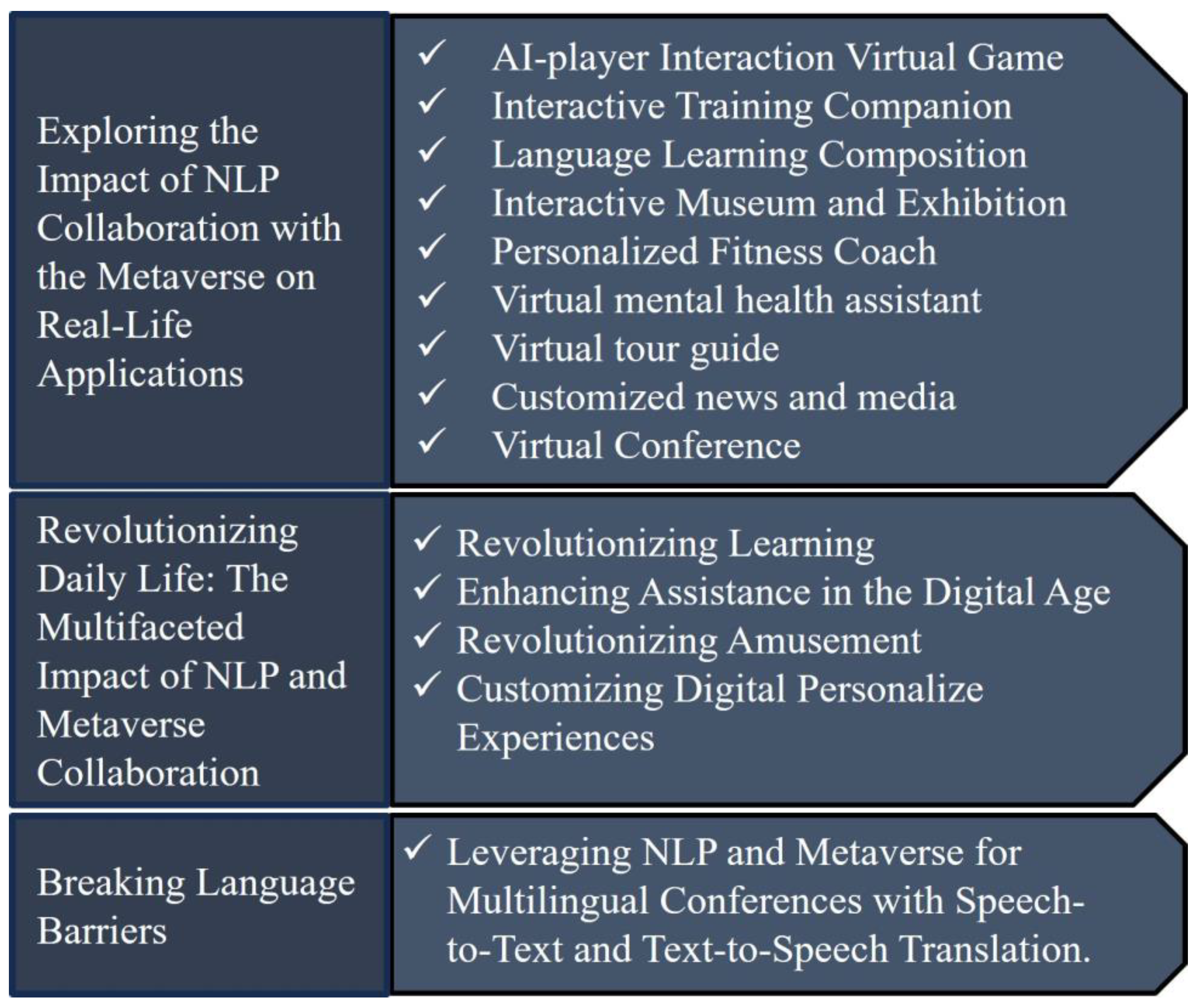
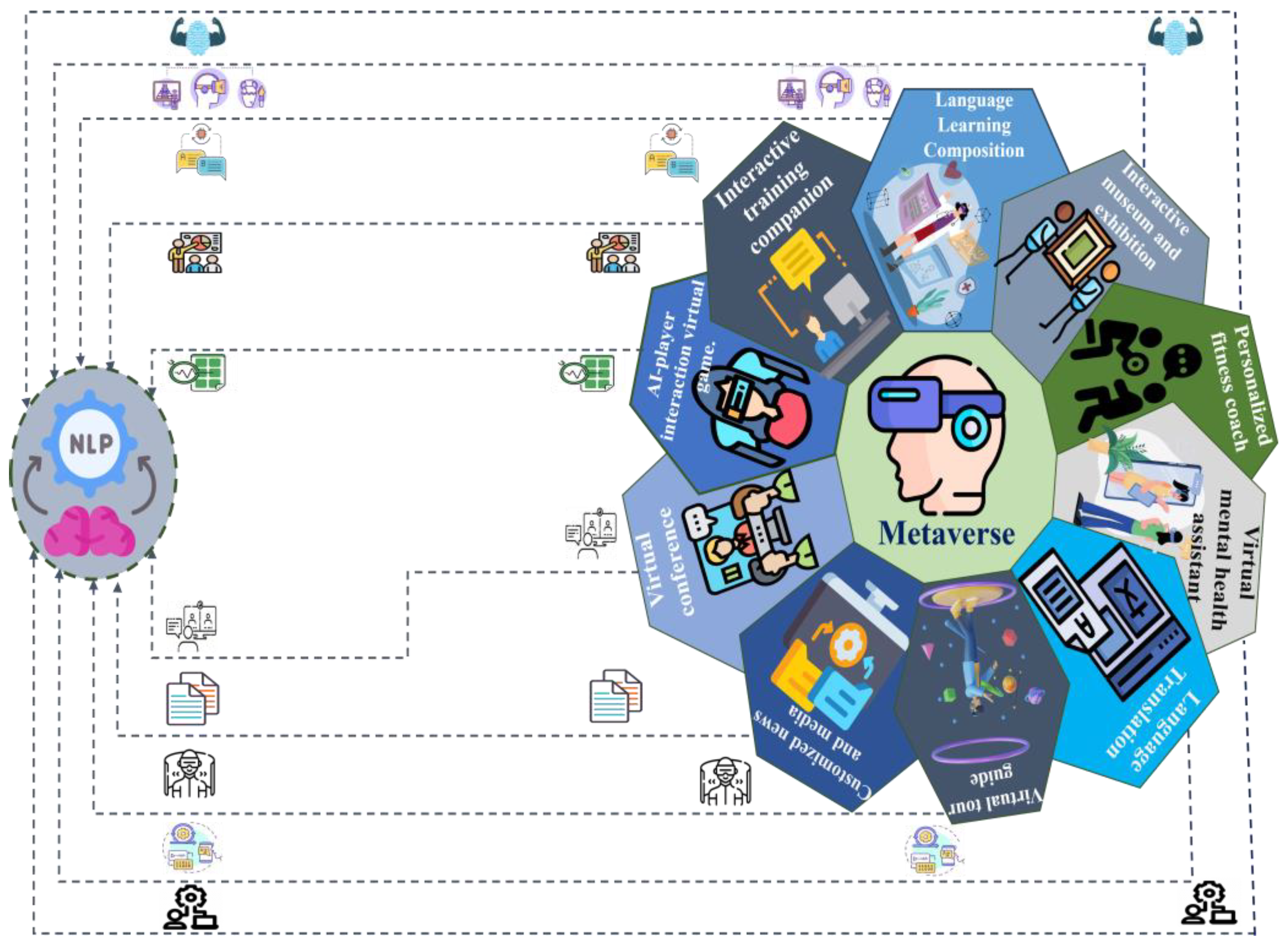
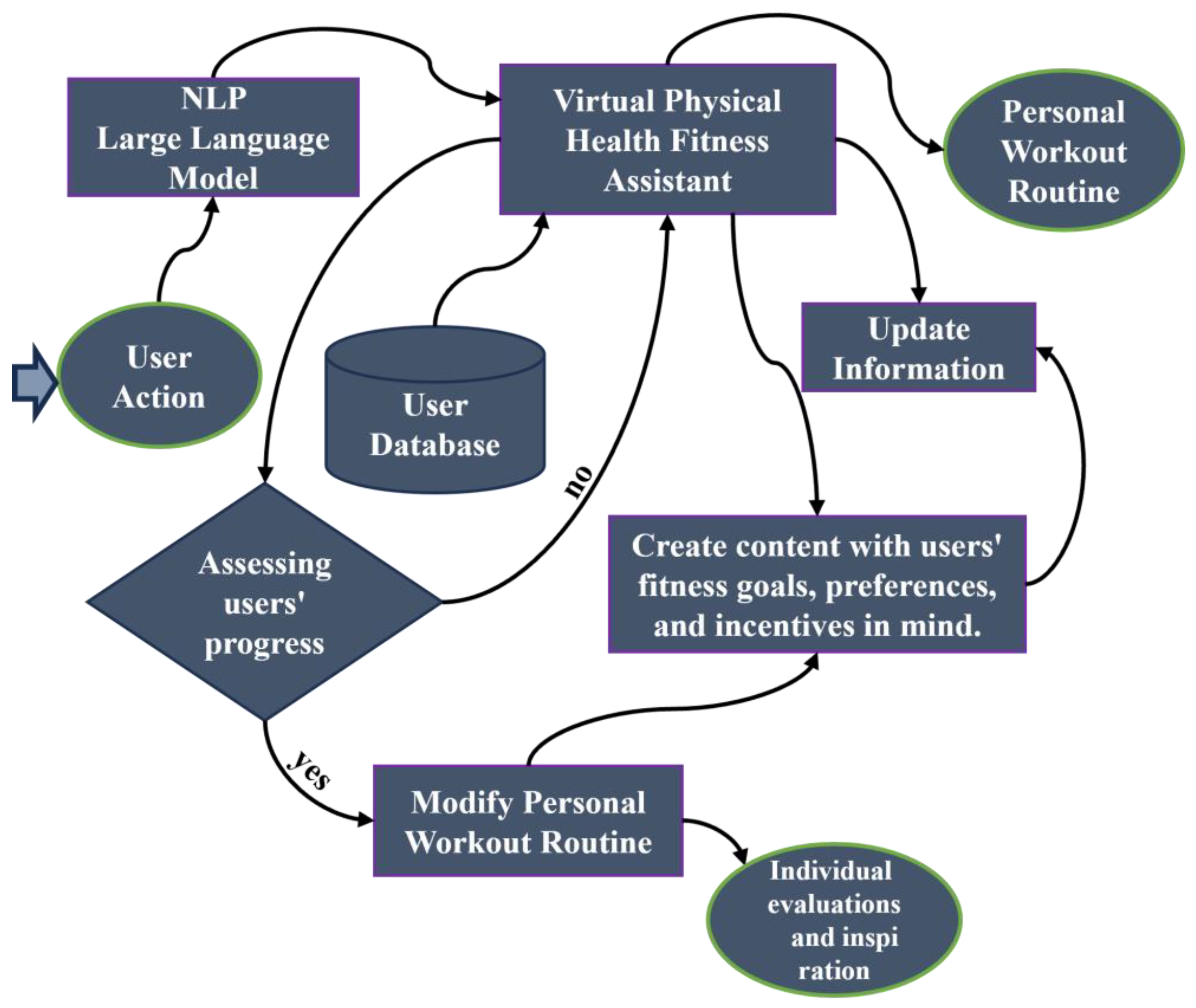
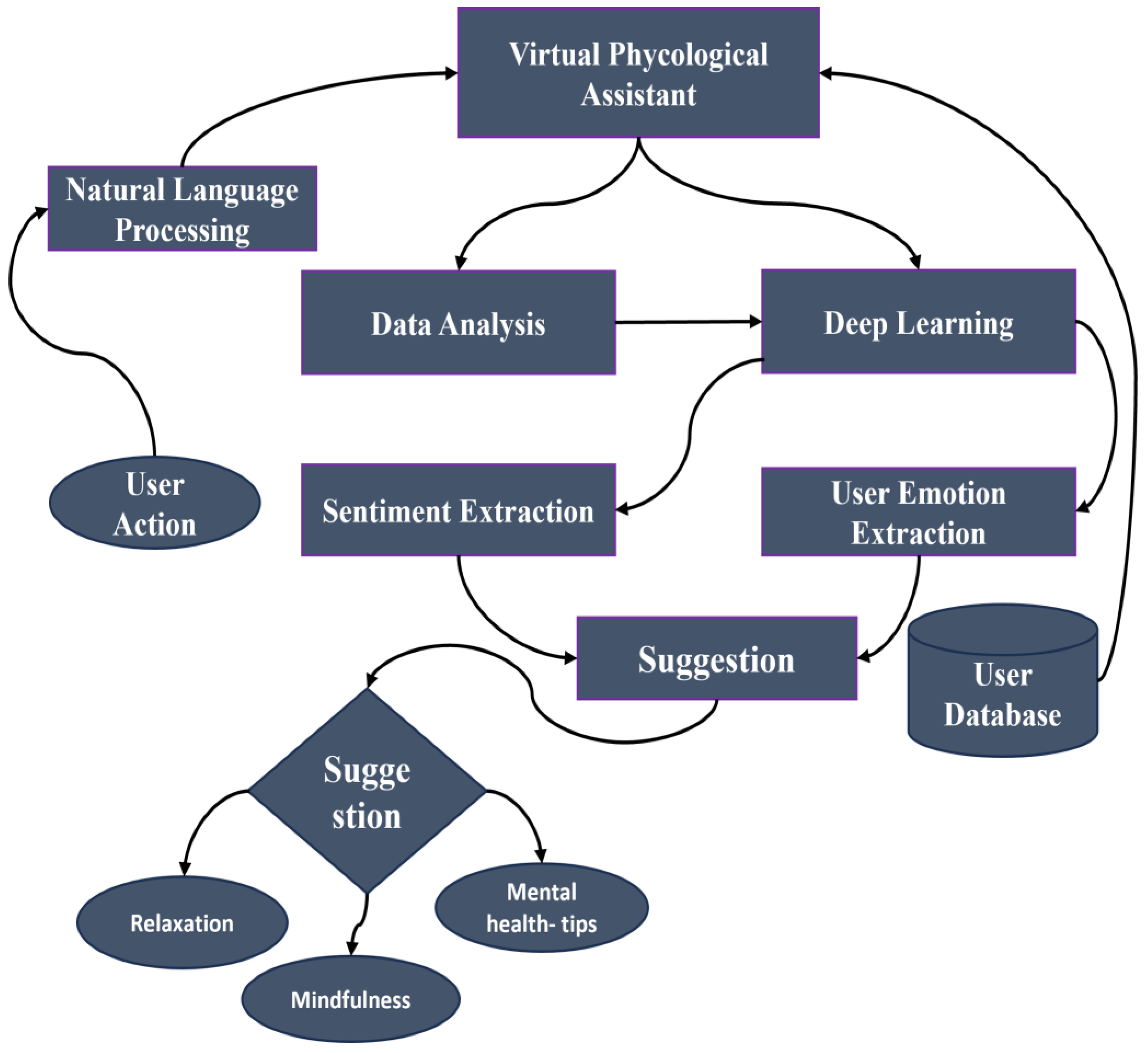
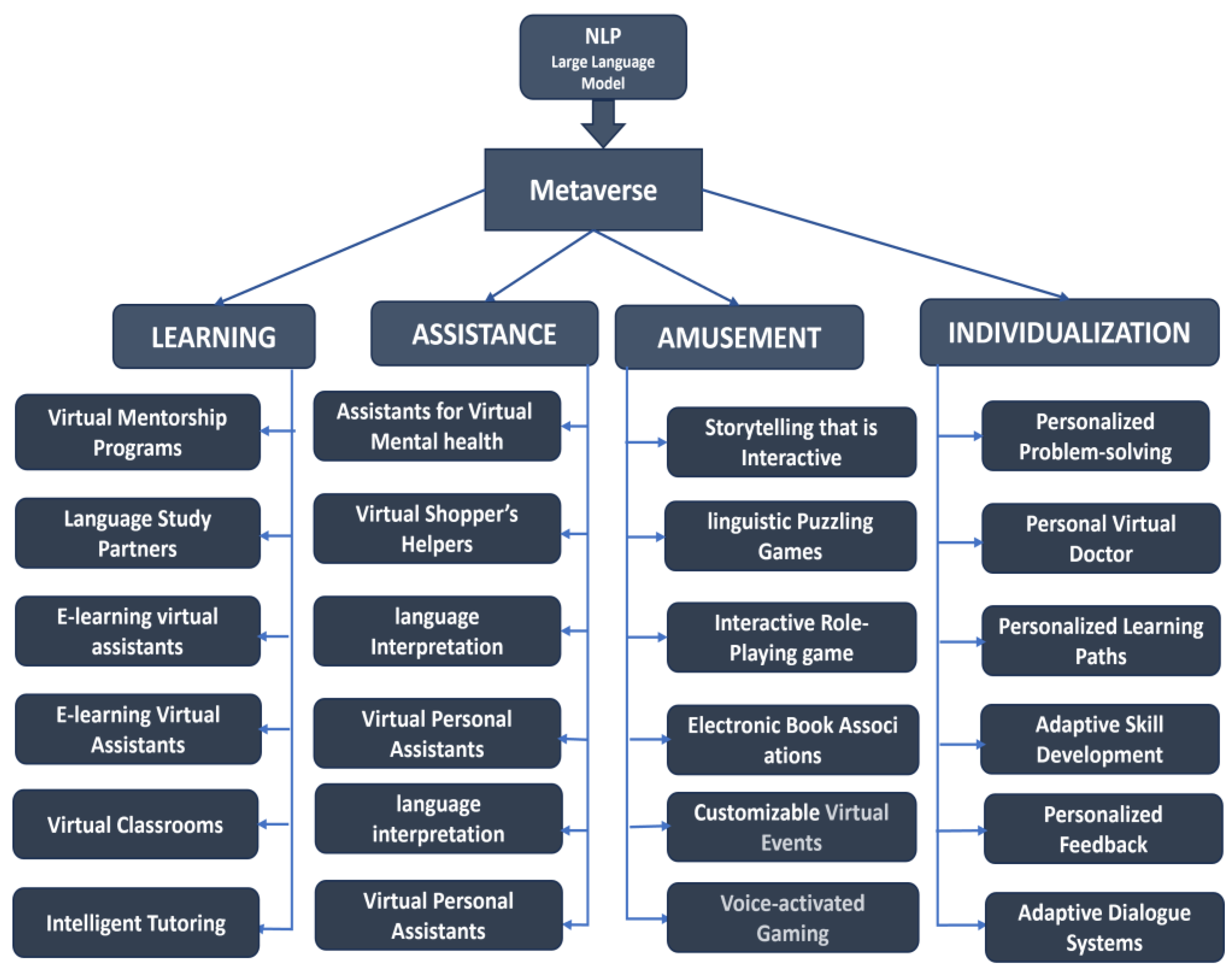
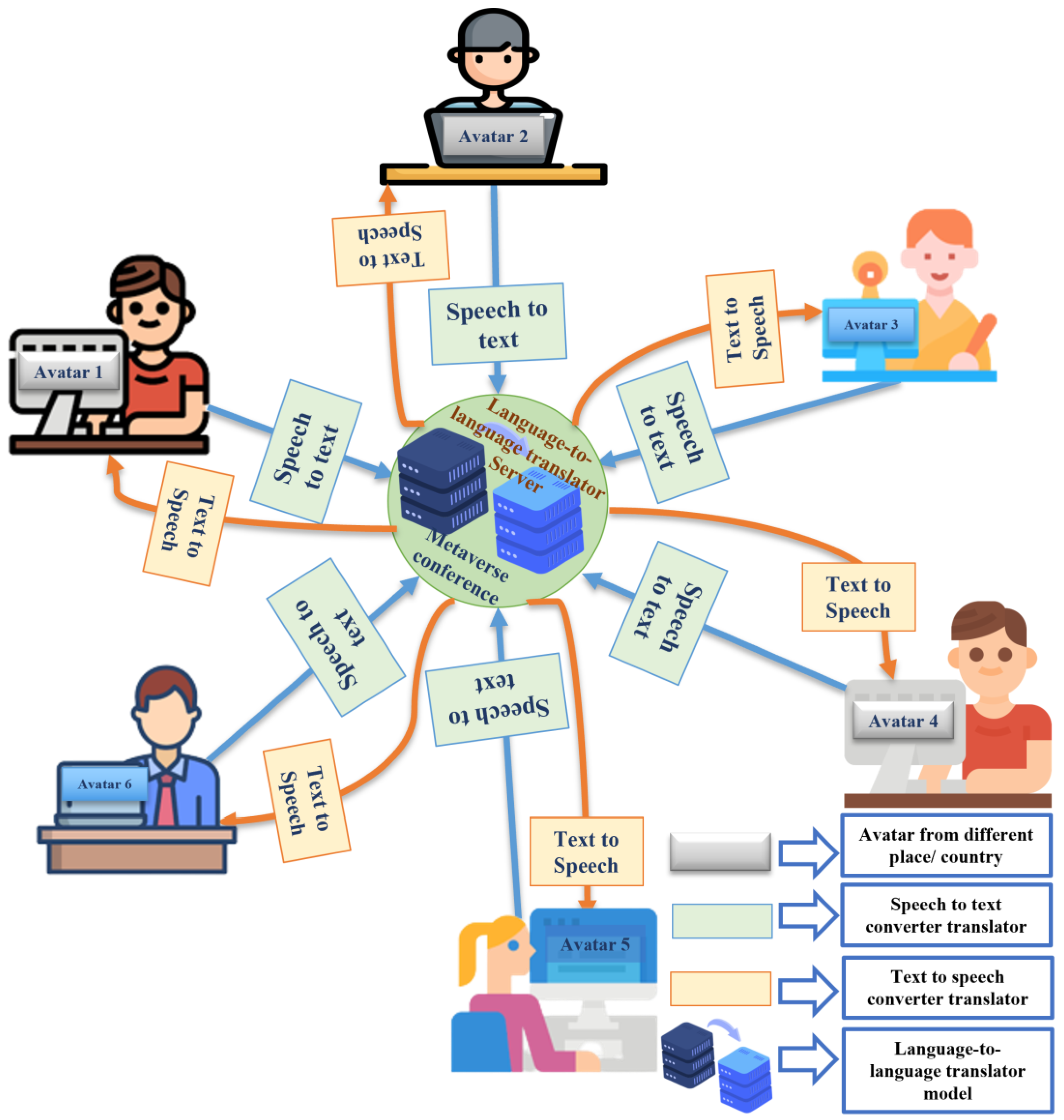
| Criteria for Evaluating XR Environments | CREAMS [70,71,72] | Ivancic et al. [73] | Kabassiand Maravelakis [74] | Sylaiou et al. [75,76] | Hammady et al. [77] | Carrozzino and Bergamasco [78] | UEQ [79] | Sutcliffe and Deol Kaur [80] | Shyam Sundar et al. [81] |
|---|---|---|---|---|---|---|---|---|---|
| Innovation/creative | x | x | |||||||
| Content/Structure | x | x | |||||||
| Social functionality | x | x | |||||||
| Enjoyment | x | x | x | x | |||||
| Learnability/usefulness | x | x | |||||||
| Sense of presence/immersion | x | x | x | x | x | ||||
| User interface and metaphors—design | x | x | |||||||
| Orientation/navigability | x | x | x | x | x | ||||
| Imageability | x | x | |||||||
| Interactivity | x | x | x | x | |||||
| Cognitive presence | x | ||||||||
| Narration | x | x | |||||||
| Usability | x | x | x | x | x | x | x |
Disclaimer/Publisher’s Note: The statements, opinions and data contained in all publications are solely those of the individual author(s) and contributor(s) and not of MDPI and/or the editor(s). MDPI and/or the editor(s) disclaim responsibility for any injury to people or property resulting from any ideas, methods, instructions or products referred to in the content. |
© 2024 by the authors. Licensee MDPI, Basel, Switzerland. This article is an open access article distributed under the terms and conditions of the Creative Commons Attribution (CC BY) license (https://creativecommons.org/licenses/by/4.0/).
Share and Cite
Sumon, R.I.; Uddin, S.M.I.; Akter, S.; Mozumder, M.A.I.; Khan, M.O.; Kim, H.-C. Natural Language Processing Influence on Digital Socialization and Linguistic Interactions in the Integration of the Metaverse in Regular Social Life. Electronics 2024, 13, 1331. https://doi.org/10.3390/electronics13071331
Sumon RI, Uddin SMI, Akter S, Mozumder MAI, Khan MO, Kim H-C. Natural Language Processing Influence on Digital Socialization and Linguistic Interactions in the Integration of the Metaverse in Regular Social Life. Electronics. 2024; 13(7):1331. https://doi.org/10.3390/electronics13071331
Chicago/Turabian StyleSumon, Rashadul Islam, Shah Muhammad Imtiyaj Uddin, Salma Akter, Md Ariful Islam Mozumder, Muhammad Omair Khan, and Hee-Cheol Kim. 2024. "Natural Language Processing Influence on Digital Socialization and Linguistic Interactions in the Integration of the Metaverse in Regular Social Life" Electronics 13, no. 7: 1331. https://doi.org/10.3390/electronics13071331
APA StyleSumon, R. I., Uddin, S. M. I., Akter, S., Mozumder, M. A. I., Khan, M. O., & Kim, H.-C. (2024). Natural Language Processing Influence on Digital Socialization and Linguistic Interactions in the Integration of the Metaverse in Regular Social Life. Electronics, 13(7), 1331. https://doi.org/10.3390/electronics13071331










